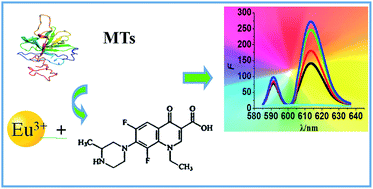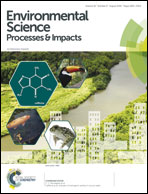Quantification of metallothioneins in the earthworm by lomefloxacin–europium(iii) fluorescent probe
Abstract
A new fluorimetric method was established for the determination of trace amounts of metallothioneins (MT) in earthworm, using a lomefloxacin–europium(III) (LMLX–Eu3+) complex as a fluorescent probe. In a pH 6.5 Tris–HCl buffer solution, MT can markedly decrease the fluorescence intensity of LMLX–Eu3+ at λ = 613 nm, and the magnitude of the decrease in this intensity was in direct proportion to the concentration of MT. The linear range was 0.08–20 mg L−1 with a detection limit of 0.022 mg L−1, and the recovery was in the range of 91.9–104.4%. The results show that the fluorimetric method is relatively accurate and sensitive to measurements of concentration for MT over a wide range. This method has been successfully applied to the determination of the concentration of MT induced by heavy metal ions (Cd2+, Pb2+, Cu2+, Zn2+) in Eisenia andrei. The amount of MT increased significantly in a dose-dependent manner to the heavy-metal exposure, and these proteins can be used as biomarkers to assess the impact of heavy-metal contamination in soils. The method offered high sensitivity as well as accuracy with simple instrumentation and is suitable for direct quantification of total MT in Eisenia andrei.


 Please wait while we load your content...
Please wait while we load your content...